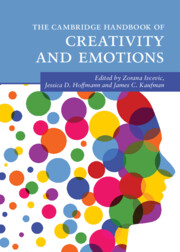Book contents
- The Cambridge Handbook of Creativity and Emotions
- Cambridge Handbooks in Psychology
- The Cambridge Handbook of Creativity and Emotions
- Copyright page
- Dedications
- Contents
- Figures
- Tables
- Contributors
- Acknowledgments
- Creativity and Emotions
- Part I Methods in the Study of Creativity and Emotions
- Part II The Development of Creativity
- Part III Emotions and the Creative Person
- Part IV Emotions and Creative Products
- 17 Emotional Creativity
- 18 Affective Factors in Dark Creativity
- 19 For Emotion’s Sake … The Centrality of Emotions in the Art Experience
- 20 The Affective Benefits of Creative Activities
- 21 Everyday Creativity as a Pathway to Meaning and Well-Being
- 22 Creative Arts Therapies
- 23 Developing Emotion Abilities through Engagement with the Arts
- Part V Emotions and Creativity at School and Work
- Index
- References
21 - Everyday Creativity as a Pathway to Meaning and Well-Being
from Part IV - Emotions and Creative Products
Published online by Cambridge University Press: 16 February 2023
- The Cambridge Handbook of Creativity and Emotions
- Cambridge Handbooks in Psychology
- The Cambridge Handbook of Creativity and Emotions
- Copyright page
- Dedications
- Contents
- Figures
- Tables
- Contributors
- Acknowledgments
- Creativity and Emotions
- Part I Methods in the Study of Creativity and Emotions
- Part II The Development of Creativity
- Part III Emotions and the Creative Person
- Part IV Emotions and Creative Products
- 17 Emotional Creativity
- 18 Affective Factors in Dark Creativity
- 19 For Emotion’s Sake … The Centrality of Emotions in the Art Experience
- 20 The Affective Benefits of Creative Activities
- 21 Everyday Creativity as a Pathway to Meaning and Well-Being
- 22 Creative Arts Therapies
- 23 Developing Emotion Abilities through Engagement with the Arts
- Part V Emotions and Creativity at School and Work
- Index
- References
Summary
This chapter explores the broader topic of creativity and positive outcomes, of which positive emotions are one. The other positive outcomes we focus on include socialization, personal growth, meaning/legacy, and flow. We first describe the various models of well-being that feature these outcomes, such as subjective well-being (SWB; Diener, 1984), psychological well-being (Ryff, 1995), flourishing (Seligman, 2011), and self-determination theory (Ryan & Deci, 2017). In the bulk of this chapter, we discuss the existing research in the creativity field related to each of these five outcomes. Major progress on this topic has been made in recent years, offering much to discuss.
- Type
- Chapter
- Information
- The Cambridge Handbook of Creativity and Emotions , pp. 394 - 410Publisher: Cambridge University PressPrint publication year: 2023
References
- 5
- Cited by

